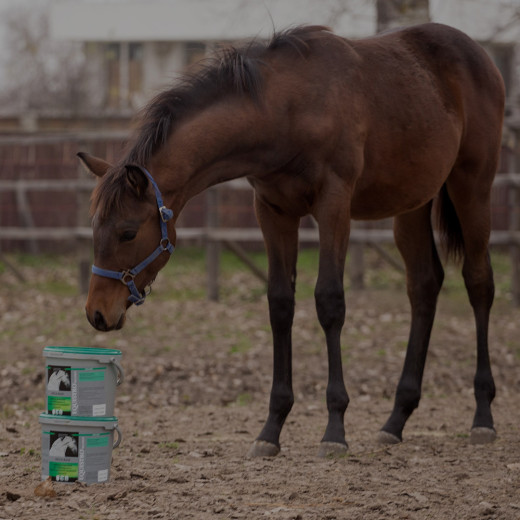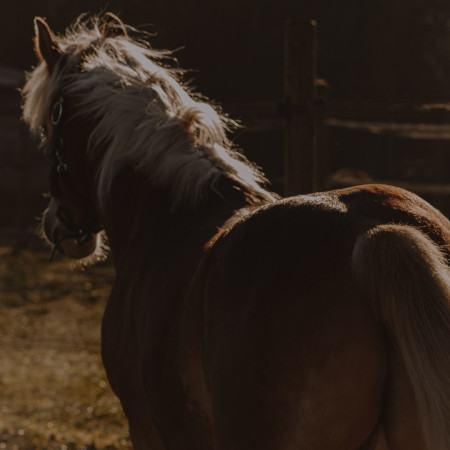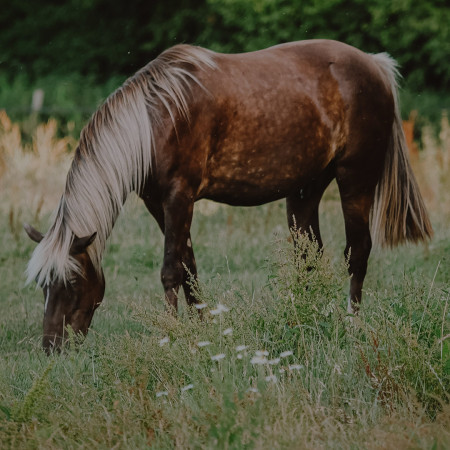
Coat change
It’s not just variations in temperature that initiate coat change – in particular the length of daylight plays the key role. The pineal gland is of importance here. One of its functions is synthesis of melatonin which is responsible for controlling the entire coat change process depending on daylight length. Particularly when temperatures become extremely high or low, the equine organism will respond by either increasing or reducing hair density and length. This also explains for example why stabled horses generally have a shorter and lighter coat than others that are kept in an open stable and thus have denser and longer hair. After the winter solstice in the middle of December with days becoming longer again, the equine organism begins with synthesis of the summer coat in the skin. This gradual process takes place more slowly than the coat change occurring in autumn, as it is first the top coat that is shed little by little, until it is then the turn of the dense underwool. By the end of June, when days are getting shorter again, the horse has already begun to change its coat for winter.
What does coat change mean for the horse's organism?
Horses often appear lethargic during coat change. It should therefore be considered very carefully how much work and effort can be expected from them at this time. Routine treatments such as deworming, vaccinations or dental procedures requiring sedation should be ideally performed before or after coat change is complete to not stress the organism on top. The additional stress on the metabolism may weaken the immune system of horses that are old or suffering from chronic disorders. A proper support especially with zinc, B vitamins and folic acid therefore should be considered in time. Loose hairs should be removed every day with brushes as the massage stimulates circulation of the skin and reduces itching caused by shedding or coat regrowth. Weight loss, muscle wasting, slow coat change or only partly loosing fur can be signs of serious disorders which require detailed investigation by a vet in suspicious cases.
Essential nutrients and useful supplementation
In addition to an increased energy requirement during coat change (around 1.5 times higher than normal), there is also a sharp rise in the need for vitamins and trace elements which hardly can be covered by the basal diet. Besides getting a balanced daily diet, which should above all include sufficient hay, a horse may require an extra in zinc, B vitamins, folic acid, and copper during coat change. Especially zinc is of importance as it is essential for the formation of new skin cells and hair follicles. B-complex vitamins as well as copper play a key role in hair synthesis and the stimulation of cell growth.
Prepare foals well for coat change from the beginning
For foals born in spring the first coat change in autumn represents a special hurdle as it often coincides with weaning and separation from the mother. This also means that their main supply of essential vitamins and trace elements – the mother’s milk – is no longer available which is associated with a huge change in their daily diet. Further stress can occur with being integrated into a group of other foals often with unknown deworming or overall health status, so making additional demands on nutrient requirements strengthening their natural immune defense mechanisms and provide them with all essential nutrients for synthesizing their first winter fur.
Offer targeted support to weak horses early on
Coat change can present an enormous challenge, above all for older or sick horses, that need special requirements during this period. If a horse has a chronic disease, the increased demand on the metabolism can weaken the immune system to such an extent that the horse can be affected by a respiratory disorder, resulting in coughing which is at risk of becoming a chronic disorder without acting in time. Should a horse not lose its coat at all or only in certain spots, this might not just be due to a lack of essential nutrients, but also a metabolic disease, which should be investigated by a vet. If coat change is severely delayed in older horses for instance, the fur partly can be clipped in spring to make sure that increasing temperatures aren’t burdening the horse’s circulation. Horses undergoing major metabolic stress (competition horses, broodmares, and breeding stallions) may prove to be deficient in nutrients despite being fed an appropriate diet, which can lead to other health issues (e.g., respiratory problems, metabolic disorders).
Dr. med. vet. Caroline Fritz






